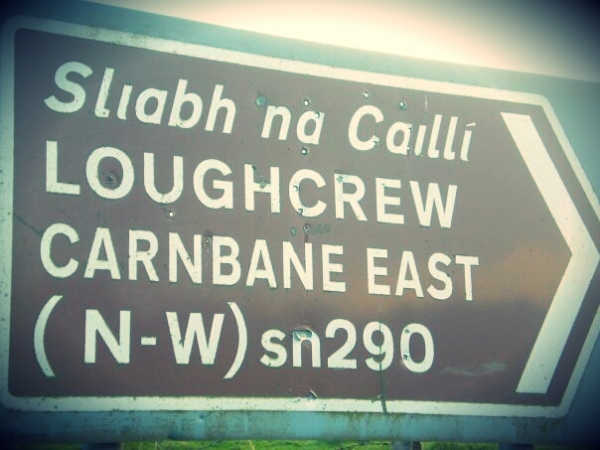
Image: Author
Something a little different today, arising out of a quick onomastic facebook post last week concerning one of the great prehistoric sites of Ireland – the Loughcrew Passage Tomb Complex, Co. Meath. September 22nd, 2013, sees the fall of the autumnal equinox in the northern hemisphere. For a day or two on either side (weather permitting, as always) visitors to Loughcrew can experience a wonderful sight as the rising sun shines directly into the main chamber of the central Tomb (Cairn T – built c.5,400 years ago) illuminating some stunning examples of neolithic passage tomb art.

The central passage tomb at Loughcrew (Image: Author)
Loughcrew (Carnbane East) lies at the summit of a small ridge with a spectacular panorama. Although partially reconstructed in the 1960s, it did not suffer the same ‘touristy tarting up’ that Newgrange, its near neighbour, did. As a result, Loughcrew provides a more simplified and personal Passage Tomb experience. With no queues, no buses, no visitor centre and surrounded by hulking echos of smaller (eroded) satellite cairns & tombs; one can very often have the whole site to yourself. Even on equinox days, the site and its landscape is never crowded with people.
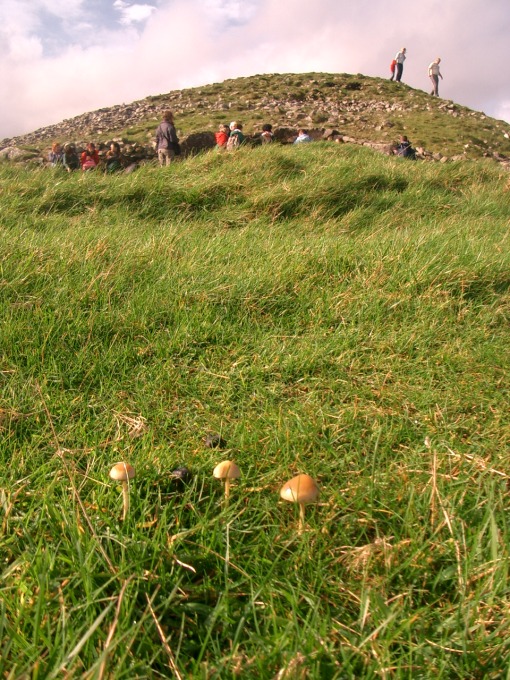
Entrance, Cairn T, Loughcrew with some autumnal psilocybe semilanceata (Liberty Caps) in foreground. I’m saying nothing. (Image: Author)
No need to get mushy
I have visited it several times but a particular favourite was on the occasion of just such an equinox morning a few years ago. And so, for the weekend that’s in it, I thought I’d throw together a few pictures along with taking a quick look at the medieval (and later) re-imagining of the sites origins in folklore.
I should probably take this opportunity to confess that prior to choosing the early medieval period for specialisation, I came within a hairs breadth of going in the opposite direction (Prehistory, the horror, the horror!) with Loughcrew & its neolithic art playing a large part in the whole affair. A small part of me still yearns for impenetrable neurophysiological treatises on entoptic phenomena…
Loughcrew: An Equinox Morning

A rising sun attempts to burn off an early equinox mist (Image: Author)
That morning was particularly misty, which very much added to the occasion. Arriving at a packed but silent carpark in the early morning gloom, we started the trek up to Cairn T. Its a short but steep enough climb with a few benches along the way for anyone who needs to take a breather. Voices eventually followed by figures, came out of the gloom. People already coming back down, convinced the mist would not lift in time.

Cairn U – a smaller satellite tomb whose remaining upright orthosats look like old gnarled teeth…almost like an old hag’s teeth… (Image: Author)
At the top, we all floated around waiting. The OPW always have guide staff up there on equinox mornings and there was a small huddle of people gathered around the entrance. Others were off on their own, enjoying their own private moments. Some children playing. Some others praying. A lovely mix of old and young. The summit of Carnbane East really is a massive site when you factor in the space between all the smaller tombs and cairns which surround the central Cairn T. The few people milling around that morning barely registered within its overall potential capacity, reminding me that such sites were designed to hold hundreds if not thousands of people.
Such places tend to be discussed in terms of ‘the few’ – the stone age ritual specialists/elites to which access to the internal chambers was probably limited. But these ‘few’ would surely have been observed by ‘the many’ – hundreds of witnesses and onlookers filling up the outside areas. Amidst the kerbstones and the satellite tombs was probably as close as one would have got to such occasions back in the neolithic. A nice reminder that participation and presence outside such tombs were as much a part of the whole shebang as being on the inside. In actuality, those on the outside would have viewed and ‘received’ the rising sunlight long before those on the inside.
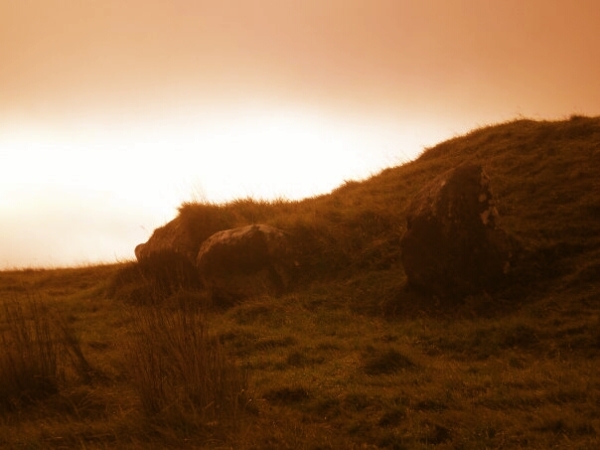
Loughcrew magic hour light. Not a bad place to meet the rising sun… (Image: Author)
The OPW staff were watching both the time & the sun burning off the mist, and eventually started calling everyone together. Everyone took it in turns to go inside the central chamber. There must have been, at any one time, about 25 people, so we rotated access several times. When sun broke eventually through the mist, although still diffused, it was enough to make a difference. Those of us outside heard the first audible gasps of appreciation from within. Someone perched high atop the tomb started a gentle rhythm on a bodhrán. Not exactly chronologically authentic, but more than appropriate all the same.
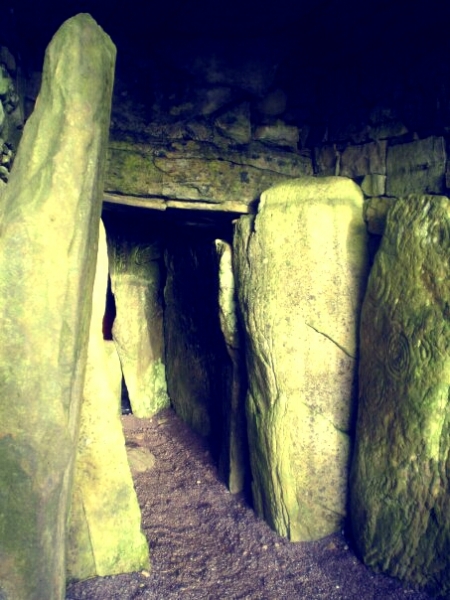
Sunlight streaming into Tomb Entrance, Cairn T. (Image: Author)
I went inside twice over the course of about twenty minutes. It was quite something to see the time-lapse passage of sunlight moving across the surface of decorated stones at the back of the chamber. Everyone marvels at the main inscribed decorations but not a lot of attention is paid to the more ‘subtextual’ decorations. The ‘pockmarked’ pecking and myriad small depressions in amongst the more overt motifs generally don’t get a look in. But in the line of transition between sharp light & darkness, the shadow moving slowing across the micro indentations of such pecked designs almost seem animated. An impossibly slow but still perceptible shadow dance across undulations in stone, especially if one were to trace it with a finger in tandem. That’s another aspect of passage tombs that doesn’t tend to get much attention outside of academic papers. It’s always seemed plausible (to me anyway) that tactile interaction with the slabs inside, in both light and darkness, played a part in ritual proceedings.

The tail end of a fading sun-kissed back stone, Cairn T. As stone age people would maybe have seen it…
(Image: Author)
Everyone else in there with me were suitably amazed for what seemed like ten seconds, and then spent the rest of their time trying to get the perfect picture. I chose to soak it all in instead. There are plenty of great pictures elsewhere on the net. They’re pretty nice and all, but not what such things are all about. The stone age designers of such tombs utilised architecture, light, darkness, touch and (probably) sound to effect an overall sensory experience. No amount of flash technology, or amplified lens filters is ever going to capture how it appears to the actual human eye. As I was leaving the second time, I took one picture, above, with no flash. It’s not very good, but I like it because of its shortcomings. In a way, it’s the closest one can maybe get to capturing and transmitting a tiny fragment of how it may have looked to neolithic eyes as the light faded.
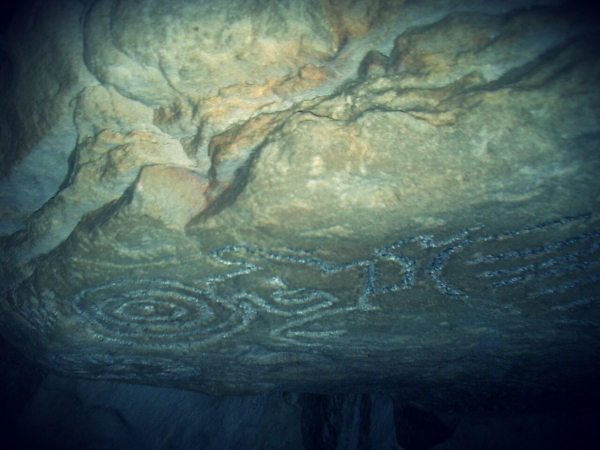
Detail of decoration on horizontal roof slab (Image: Author)
Above is a picture, taken at another time in artificial light, of some of the motifs carved on one of the horizontal roof slabs. Always look up in a passage tomb. (Many people never do!) This is one of the more overt examples of neolithic intent and agency. Such slabs, where we can see them at Loughcrew and elsewhere, because of their relative inaccessibility show that neolithic people sometimes decorated them prior to final placement/tomb construction. Excavation at some passage tombs have previously revealed decorated stones that would never have been seen when such tombs were finished construction.

The back stone in artificial light (Image: Author)
The main back stone which receives the equinox light, again taken at another time in artificial light. I could go on and on about this one. Perhaps the most interesting thing, is its ‘depictive style’; a term used by some archaeologists to designate elements and motifs which seem to have been individually carved, at different times, without much consideration, or relationship to the those done previously. It’s an archaeology ‘of the now’, without much regard to the future.
Elsewhere at Loughcrew (and other such tombs – particularly on slabs at or near the entrances) a different design is thought to have been employed later on – one which involved an overall intention and inclusiveness of the entire stone surface/canvass, with several designs and motifs both respecting and interacting with each other. This is thought to be representative of a shift in neolithic intent. A more open design, with an eye towards larger public visibility. An ‘opening up’ perhaps of the tombs inner areas, at least to some visitors.
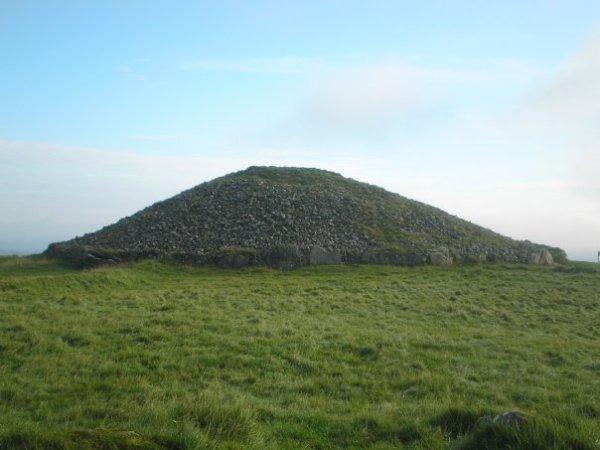
The ‘rear’ of Cairn T, looking east (Image: Author) – You could fit a lot of people around it, all of whom would have a clear view of the cairn itself and the rising equinox sun behind it. A great natural elevated ‘theatre space’ for ritual performances…
Surprisingly, as soon as the direct sunlight had passed, everyone pretty much packed up and left, leaving my party and a couple of new age mystical types the only people remaining. The new agers were engaging in some version of a ritual which involved circumnavigating the tomb, enclosing it in a line of brightly coloured powder. They seemed put out by our continued presence around the entrance way, so we withdrew to the back of the cairn, to let them finish their business. This done, they had a bit of a meditation at the top before leaving. Within a relatively short period, even on an equinox morning, we had the place to ourselves.
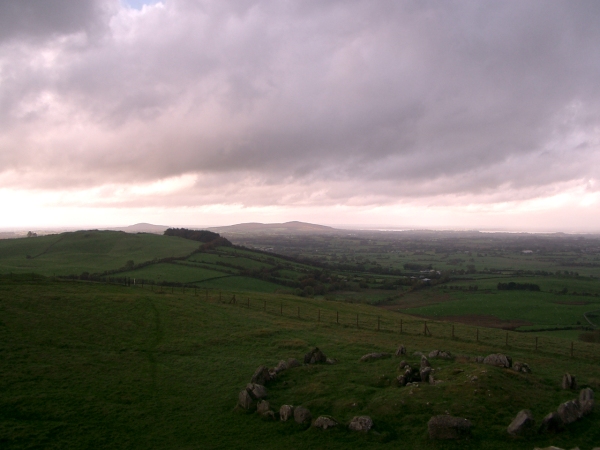
Northwest view from the summit of Cairn T. Carnbane West (another passage tomb) in the near distance
(Image: Author)

The view to the west, from Cairn U (Image: Author)
Imagine having these views, alongside this much archaeology, all to yourself. That is what is particularly special about Loughcrew. It’s just the right distance off the beaten track, with just the right level of elevation and ‘walking only’ accessibility to keep it off the radar of more general motorised tourism. Long may it continue.
But what about the medieval hags, you say. Where do they come into it?
That, as they say, would be an ecumenical matter…
(To be continued)
+ + +
***For details of 2014 OPW/Equinox times: see here.***
For a wonderful interactive virtual-reality experience of the tombs in their landscape setting, see the page on Loughcrew provided by http://www.voicesfromthedawn.com
+ + +
Bibliography & Futher Reading
Bradley, R. 1989. Deaths and Entrances: A Contextual Analysis of Megalithic Art. Current Anthropology 30, 68-75.
Dronfield, J. 1995. Subjective vision and the source of Irish Megalithic Art. Antiquity 69, 539-549.
Dronfield, J. 1996. The Vision Thing: Diagnosis of Endogenous Derivation in Abstract Arts. Current Anthropology 37, 373-391.
Eogan, G. 1986. Knowth and the Passage Tombs of Ireland. London.
Fraser, S.H. 1998. The Public Forum and the Space Between: the Materiality of Social Strategy in the Irish Neolithic. Proceedings of the Prehistoric Society 64, 203-224.
Lewis-Williams, J.D. & Dowson, T.A. 1993. On Vision and Power in the Neolithic: Evidence from the Decorated Monuments. Current Anthropology 34, 55-65.
McMann, J. 1994. Forms of power: dimensions of an Irish megalithic landscape. Antiquity 68, 525-544.
O’ Sullivan, M. 1986. Approaches to Passage Tomb Art. Journal of the Royal Society of Antiquaries of Ireland 116, 68-83.
O’ Sullivan, M. 1989. A Stylistic Revolution in the Megalithic Art of the Boyne Valley. Archaeology Ireland 3 (4), 138-142.
Patton, M. 1990. On Entoptic Images in Context: Art, Monuments and Society in Neolithic Brittany. Current Anthropology 31, 554-558.
Pearson, M. & Thomas, J. 1994. Theatre/Archaeology. TDR 38, 133-161.
Shee Twohig, E. 1981. Megalithic Art of Western Europe. Oxford: Clarendon Press.
Sheridan, A. 1986. Megaliths and Meglomania: An Account, and Interpretation, of the Development of Passage Tombs in Ireland. Journal of Irish Archaeology III, 17-30.
Thomas, J. 1990. Monuments from the Inside: The Case of the Irish Megalithic Tombs. World Archaeology 22, 168-178.

Great article and photos. Would you mind if I reproduced it in a small privately circulated e-zine?
LikeLike
Hi there. Many thanks for your interest.
I presume that, if you’re asking, then the e-zine does not conform with the terms of my CC BY-NC-ND 3.0 licence. In which case, I would politely decline. To be honest, the main reason I write this blog is to share my work to interested parties in an open, non-exclusive, non-commercial, non-journal environment; whilst retaining creative control and copyright. Private circulation strikes me as the very opposite of what I do here (and also reminds me why I don’t limit myself to academic journals/paywalls). In addition, I don’t see why anyone should have the potential to make money from my blog, when I don’t make anything myself.
You’re more than welcome to link to it though. It would be much appreciated.
Best regards.
http://creativecommons.org/licenses/by-nc-nd/3.0/deed.en_GB
LikeLike
Thanks for your response and I quite understand your position.
Just to clarify, the e-zine I publish is for a specific pagan audience and there are no subscriptions. It is freely available, just limited to a specific type of pagan. The reason is that some of the material is of a sensitive nature (not offensive or abusive, just sensitive to those who write it) so we limit the distribution. The e-zine has been published continuously since the mid 1970s although in its early days it was printed (on an old gestetner machine!) and only made the transition to e-zine in the 1990s. We published print and e-zine for a while but for the last few years it has been e-zine only.
Thanks for taking the time to respond.
LikeLike
Cheers, No worries. Thanks for understanding.
By the way, I did check out the ezine site/background before replying. All the best with it.
If I might make a suggestion, you might get a better response from others if you were to reassess the sites own copyright statements. Asking CC Licencees to re-publish their work, whilst proclaiming your own ownership/a.n.other doesn’t come across very well. Just a friendly thought.
Cheers again.
LikeLike
Cheers, Terry.
Very interesting to hear your thoughts on Loughcrew. I’ve enjoyed visiting it frequently over the years, but haven’t got there on equinox morning — yet. I do find it interesting that the carvings seem to represent real objects like leaves, trees, or the sun, while so many of the other tombs appear to be more like geometric patterns.
LikeLike
Cheers mate. Aye, its something special to be sure.
Yeah there is such an interesting dichotomy between two extremes of imagery. The geometric stuff also appears on neo pottery sometimes, I often wonder about a cross over going on. Definite hint of display or decoration tones. And then the more objective ones, I see what you mean. I would imagine the leaves/vegetation interp is probably not a million miles off. Interesting also, given the autumnal time frame too. Having said that, these things were being done by many successive generations over centuries, if not millennia, in some tombs. Entirely possible that the iconography was many different things to different people in different times.
I think we sometimes forget the staggeringly long space/time dimensions involved in such things. People walking into an 800 year old church nowadays find it hard to recognise symbolism and carvings without a guide book. Go into a 17th century graveyard and many would have trouble with the iconography on headstones and thats only 400 years ago. Imagine something like 1300 years apart.
Cheers again, appreciate it.
LikeLike
What a wonderful post… I smiled at your comment about prehistory… a site like this confirms me in my interest of that period.
This is really interesting, and super pics, thank you!
LikeLike
Glad you liked it. Many thanks for taking the time to say so. As always, any prehistory jibes are firmly tongue in cheek. Its actually a rule or something in medievalist school. We’re obliged to do so whenever we get a chance. I quite like prehistorians. But I could never eat a whole one 😉
LikeLike
I actually laughed out loud at that – wine all over the keyboard!
LikeLike
My work here is done 🙂
LikeLike